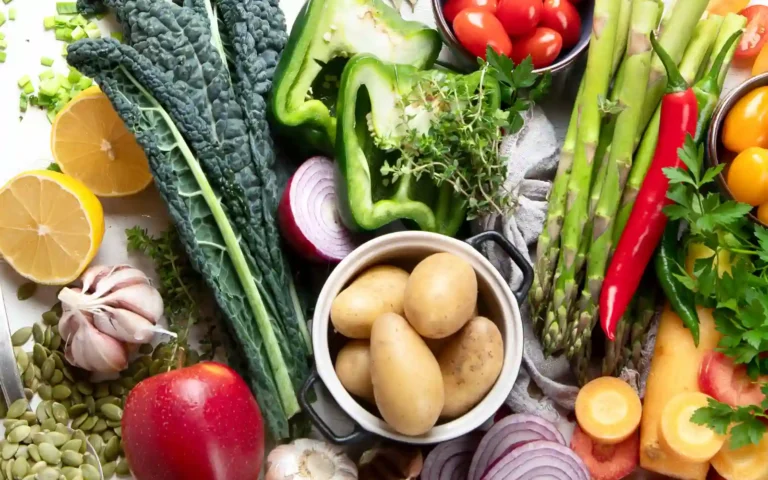The low FODMAP and anti-inflammatory diet has been increasingly growing in popularity for many years for a variety of reasons. Both dietary approaches have several benefits when it comes to improving overall health and wellness. Many individuals not only look to these dietary approaches for general health improvement but also for symptom relief from bothersome and uncomfortable gastrointestinal issues often associated with conditions such as Irritable Bowel Syndrome or IBS.
In this article, we will explore the variety of benefits offered by both diet approaches and learn further strategies on how these approaches can be utilized individually or in conjunction with one another as well as learn how these approaches further benefit digestive health for individuals seeking symptom relief.

Anti-Inflammatory Diet vs FODMAP
There are a few differences between the anti-inflammatory diet and the FODMAP diet. The anti-inflammatory diet is intended to be a lifestyle modification with lifelong sustainability, whereas the low FODMAP diet is a short-term elimination diet meant to identify and reduce food-related triggers contributing to adverse GI symptoms. However, the FODMAP maintenance phase is one that can be utilized lifelong once food triggers have been identified and you are back to eating as normally as possible with as many foods as can be tolerated and included.
The anti-inflammatory diet approach is less focused on identifying food triggers, rather it emphasizes ways to increase dietary fiber, intake of healthy fats, and addition of colorful plant-based foods to lower levels of chronic inflammation in the body. Each dietary approach discussed has its benefits. If your GI symptoms are triggered by unknown food intolerances, it may be best to first start with a low FODMAP elimination diet. If your GI symptoms may be exacerbated by chronic stress or potentially an autoimmune condition, it may be beneficial to first start in implementing the anti-inflammatory diet before starting an elimination diet such as FODMAP which can at times be very restrictive and hard to maintain long-term.
Ideally, the maintenance phase of the FODMAP approach would be a great place to add back in anti-inflammatory foods for symptom management. The benefits to each dietary approach are vast, and learning how to bridge the two diets together can be very useful in overall reduction of inflammation in the body for lifelong symptom management.
Anti-Inflammatory Diet Basics
An anti-inflammatory diet prioritizes several key components including minimizing processed foods, increasing dietary fiber intake, incorporating omega-3 heart healthy fatty acids, and including various lean proteins from plant and animal based sources while also implementing various spices [1]. This diet ultimately works to minimize intake of trans and saturated fats that can contribute to inflammation in the body and a pro-inflammatory state [2]. Also this diet approach focuses on plant-based food choices that are rich in color and packed with powerful vitamins and minerals.
Important to know that not all inflammation in the body is considered harmful. In fact, when a foreign invader enters the body, we need our immune system to act quickly to provide defense and this can often be seen at the site of an infection with a healing cut, swelling, warmth, or redness. As the damage is repaired, the inflammation reduces which is a sign of a healthy immune system.
When inflammation becomes chronic and over a prolonged period of time it can damage surrounding healthy cells in the body and may even contribute to the development of certain autoimmune conditions [3]. Lifestyle factors including high stress levels, lack of exercise, and poor dietary habits can also contribute to the development of inflammation and may worsen pre-existing inflammation in the body over time. Research has indicated that certain conditions such as diabetes, heart disease, and even fatty liver disease may be linked to chronic inflammation [3].
Foods may promote and contribute to a pro-inflammatory state in the body. A diet that is often associated with a pro-inflammatory state would be the Western diet. Foods that may promote a pro-inflammatory state in the body due to higher amounts of saturated fat, refined sugars, and excess sodium include [3]:
- Sugar-sweetened beverages such as juices and soda
- White flour-based products or refined/simple carbohydrates are low in dietary fiber
- Fried foods
- Whole-fat dairy is higher in saturated fat, such as cream and butter
- Saturated fat is found in processed meats and higher-fat cuts of red meat
- Excess alcohol
- Trans Fats, which may be found in highly processed baked goods and fried foods
Ultimately, the anti-inflammatory diet is a lifestyle choice that highlights a variety of food groups to be included in the diet while also promoting healthy lifestyle changes by managing stress levels, improving sleep quality, and exercising.
Anti-Inflammatory Foods and Nutrients
The following foods, vitamins, and minerals can be included on an anti-inflammatory diet approach with a focus on obtaining these nutrients from the diet and whole foods rather than supplements.
Antioxidants
The National Cancer Institute defines an antioxidant as a substance that provides protection to our cells from harmful substances known as free radicals that can cause damage in our bodies and may play a role in the development of certain diseases, such as heart disease and cancer [5]. Antioxidants include Vitamins A, C, and E. Additional minerals that can assist with reduction of inflammation include Selenium and Zinc. Food sources of these include:
- Vitamin A: Vitamin A-rich food sources include sweet potatoes, carrots, spinach, salmon, papaya, and apricots.
- Vitamin C: Vitamin C-rich food sources include red bell peppers, oranges, kiwi, broccoli, strawberries, brussels sprouts, and cantaloupe.
- Vitamin E: Vitamin E-rich food sources include sunflower seeds, almonds, hazelnuts, olive oil, dried mango, swiss chard, avocado, and blackberries.
- Selenium: Selenium-rich food sources include halibut, yellowfin tuna, shrimp, turkey, sunflower seeds, and lentils.
- Zinc: Zinc-rich food sources include oysters, lobster, chicken, pumpkin seeds, pine nuts, chickpeas, and green peas.
Dietary Fiber
Mayo Clinic defines dietary fiber as the parts of plants that cannot be digested or absorbed by our bodies and pass intact through our body to our small intestine and colon [6]. Foods rich in dietary fiber should be included when following an anti-inflammatory diet approach. These food choices include:
- Fruit: All types of fruits can be included – aim to “eat the rainbow!” A few examples of fruits that provide anti-inflammatory benefits are berries, apples, pomegranates, cherries, and grapes.
- Vegetables: All vegetables can be included – aim to “eat the rainbow!” Focusing on high fiber cruciferous vegetables can be beneficial by including green leafy vegetables, broccoli, cauliflower, cabbage, bok choy, and Brussels sprouts.
- Whole grains: Whole grain food-based sources are rich in fiber and vitamins and minerals, and include options such as oatmeal, whole grain bread, whole grain crackers, whole grain pasta, barley, and quinoa, to name a few.
Omega-3 Fatty Acids
Cleveland Clinic defines Omega-3 fatty acids as heart-healthy fats that are essential to health in providing heart-healthy benefits, including lowering cholesterol levels as well as lowering cardiovascular risk factors [7].
- Omega-3 Fatty Acids: Omega-3-rich food sources can be found in nuts, seeds, olive oil, avocado, chia and flax seeds, and fatty fish such as salmon and tuna.
Probiotics
The National Institute of Health Office of Dietary Supplements defines a probiotic as a live microorganism that, when consumed in the diet, can provide benefits to the host in diversifying and adding beneficial good bacteria to the gut [8].
- Probiotic Foods: Probiotic-rich foods include yogurt, kefir, sauerkraut, kimchi, pickled and fermented foods with live cultures, cottage cheese with live active cultures, and kombucha.
Other nutrients that can be included in an anti-inflammatory diet pattern
- Plant-based proteins: Including beans, legumes, tofu, and edamame can be part of an anti-inflammatory diet, given their low saturated fat content and high fiber benefits.
- Other items to include would be coffee, green tea, and spices such as cinnamon, turmeric, ginger, and garlic.
If you are looking to follow a more specific approach to the anti-inflammatory diet, then it is recommended to follow a Mediterranean Diet approach, which prioritizes many of the anti-inflammatory dietary guidelines discussed. For more information on how to follow a Mediterranean Diet, please reference Table A3-5 in the 2020-2025 Dietary Guidelines for Americans, which gives reference amounts for fruits and vegetables, protein choices, oils, and grain amounts for specific caloric requirements across the lifespan [9].
Does an Anti-Inflammatory Diet help with IBS?
Yes, the anti-inflammatory diet can help with IBS-related symptoms, given that this diet approach works to lower inflammation in the body. Research suggests that chronic inflammation in the body exacerbates symptoms of IBS [10]. There is emerging research that indicates a strong connection between our gut health and our brain health. Essentially, this means that chronic levels of stress may be resulting in inflammation in our guts that can majorly contribute to and impact IBS-related symptoms [11]. Lowering inflammation in the body allows the good bacteria in our guts to thrive and flourish, and promote a healthy gut environment. When the good bacteria in our guts can flourish, it allows for better digestion and nutrient utilization with fewer instances of adverse GI symptoms.
The Impact of the Anti-Inflammatory Diet on Gut Microbiota
Multiple studies have concluded that our diets largely influence and impact the health of our gut microbiome as well as the diversity of the bacteria in our gut [1]. The anti-inflammatory diet has several key nutrients responsible for diversifying the gut microbiome and providing several important health benefits as a result.
One key nutrient of the anti-inflammatory diet is dietary fiber. Dietary fiber is found in a wide range of plant-based food choices, including fruits, vegetables, whole grains, legumes, nuts, and seeds. The bacteria and microorganisms that reside in the gut go through a process known as fermentation, which essentially breaks down the dietary fiber that was consumed. When the dietary fiber is broken down, end products known as Short Chain Fatty Acids (SCFA) are produced.
Research has shown that production of SCFAs from increased dietary fiber intake can demonstrate anti-inflammatory properties as well as assist in chronic disease prevention in a number of chronic diseases, including obesity, cardiovascular disease, diabetes, inflammatory bowel disease, and liver disease, to name a few [12]. By incorporating more anti-inflammatory fiber-rich foods into dietary intake, our gut microbiome benefits by being able to produce SCFAs that can then assist with our body’s immune system response to fight pro-inflammatory metabolites that may be present and assist in the prevention of developing chronic diseases [12].
Low FODMAP Diet Basics
This diet approach is a type of elimination diet geared towards helping individuals with IBS or digestive discomfort better identify potential food triggers that may be contributing to symptoms. This diet approach is meant to be an elimination-style diet for 2-6 weeks with total elimination of foods known as FODMAPs (groups of fermentable carbohydrates that are not digested well in certain individuals and lead to poor digestion and fermentation in the gut, often resulting in uncomfortable symptoms of gas, bloating, pain, constipation, or diarrhea). The low FODMAP diet is composed of 3 main phases, including:
- Elimination Phase: total elimination of high FODMAP foods for 2-6 weeks
- Reintroduction Phase: this phase involves an individual trial of each of the main FODMAP groups to test and note tolerance over a period of 3-5 days
- Maintenance Phase: food triggers have been identified and reduced or eliminated in the diet, and the individual is allowed to include as many foods that are tolerated to be included in the diet
By identifying food triggers through the low FODMAP diet, this can be helpful in reducing inflammation in our gut as well as reducing inflammation in the body that is caused by stress from unknown reactions to particular foods in the diet.

Low FODMAP Anti-Inflammatory Foods
Throughout the article, we have identified foods that are anti-inflammatory, with a wide variety of foods identified to be plant-based food choices. The great news is that many foods are considered to have anti-inflammatory benefits, and the key is to have variety and as many colors in the diet as possible for maximum benefit. For individuals following a low FODMAP diet actively during the elimination phase, it can be helpful to continue incorporating foods that may reduce inflammation for symptom management with anti-inflammatory food choices.
Low FODMAP Anti-Inflammatory Foods include:
Fruit:
- Berries: blueberries, strawberries, raspberries
- Clementines or oranges
- Cantaloupe
- Papaya
- Kiwi
Vegetables:
- Leafy greens such as arugula, kale, spinach
- Bok Choy
- Sweet potato (low FODMAP serving of ½ cup per meal)
- Colorful vegetables, including tomato, carrots, and bell peppers
Omega-3’s:
- Salmon
- Tuna
- Chia seeds or flax seeds
- Pumpkin seeds
- Sunflower seeds
- Avocado (low FODMAP serving is 3 tablespoons per meal)
- Walnuts, almonds, pine nuts
- Olive oil
- Olives
Grains:
- Brown rice
- Quinoa
- Oats
Probiotics:
- Plain Lifeway Kefir or Green Valley Plain Lactose Free Unsweetened Kefir
- Lactose-free yogurt with live active cultures
- Lactose-free live active culture cottage cheese
- Unflavored kombucha (low FODMAP serving is 180 mL per meal)
Spices:
- Turmeric
- Cinnamon
- Ginger root
Other:
- Coffee
- Tea
- Dark Chocolate
How to Implement a Dual Approach with Low FODMAP Anti-Inflammatory Foods
Please see the following menu example below for learning further strategies on how the low FODMAP diet may be combined with anti-inflammatory foods. The following foods can be implemented at any stage of these two diets. For more exact serving sizes that are low in FODMAP, please refer to the Monash App for additional suggestions on portion sizing. The following menu is meant to provide examples of how to implement food-based sources that are low in FODMAP and provide additional nutrients of omega-3s, fiber, antioxidants, and probiotics.
Sample Menu
Breakfast: Power Up Smoothie
- 1 cup Green Valley Lactose Free Plain Unsweetened Kefir
- 1 cup blueberries
- 2 tablespoons chia seeds
- 1 cup baby spinach
- Nutrition: 296 calories, 15.7g protein, 39.6g carbs, 9.2g fat, 11.3g fiber
Lunch Nourish Bowl
- ¾ cup cooked quinoa
- ½ cup sweet potato
- 3 oz cooked salmon (wild caught preferred)
- 1 cup cooked kale
- 2 tbsp pumpkin seeds (unsalted preferred)
- 1 tbsp Garden Herb Fody Foods Sauce
- Nutrition: 588 calories, 37.4g protein, 56.7g carbs, 24.9g fat, 12.5g fiber
Snack Plate:
- Orange
- ⅓ cup dry roasted and unsalted edamame beans
- Nutrition: 222 calories, 15.2g protein, 24.4g carbs, 6.2g fat, 7.1g fiber
Mediterranean Bowl Dinner:
- 1.5 cups leafy greens
- 3 oz skinless cooked chicken breast
- ⅓ of a medium cucumber
- ¼ cup canned and drained garbanzo beans
- 5 medium cherry tomatoes (low FODMAP serving size)
- 2 tablespoons crumbled feta
- ½ cup cooked brown rice
- 1.5 tablespoons of Fody Foods Balsamic Vinaigrette
- Nutrition: 507 calories, 38.8g protein, 49.9g carbs, 16.4g fat, 10.4g fiber
Dessert:
- 1 cup hot green tea
- ¼ bar of Hu Simple Organic Dark Chocolate 70% Cacao
- Nutrition: 95 calories, 1.5g protein, 7.5g carbs, 7.0g fat, 1.5g fiber
Total Nutrition Breakdown:
- Calories: 1708
- Protein: 108.6g
- Carbohydrates: 178.1g
- Fat: 63.7g
- Fiber: 42.8g
Please keep in mind nutrition is individualized and everyone has individual goals for calories, macronutrients, and fiber intake.
FAQ’s:
-
Are low-GI foods anti-inflammatory?
- Yes, low glycemic index foods are anti-inflammatory food choices, given that lower glycemic index foods contain higher amounts of dietary fiber, which means that blood sugar levels are less likely to be elevated after a meal or snack choice. Higher fiber food choices that are low in glycemic index and provide antioxidants for fighting inflammation include foods such as beans, oats, quinoa, berries, and green leafy vegetables.
-
What foods are anti-inflammatory for the gut?
- Anti-inflammatory foods for the gut include omega-3-rich foods, probiotic food sources, whole grains, and colorful fruits and vegetables.
-
What is a low FODMAP anti-inflammatory diet?
- A low FODMAP anti-inflammatory diet means following a dietary pattern that is low in fermentable carbohydrates while also focusing on adding in foods that are not only low in FODMAP but also provide beneficial anti-inflammatory nutrients such as probiotics, antioxidants, omega-3s, and dietary fiber.
-
What are low FODMAP anti-inflammatory foods?
- Low FODMAP anti-inflammatory foods include berries, oranges, leafy greens, nuts and seeds, fatty fish, and lactose-free dairy products with live and active cultures for probiotics.
-
Is the Low FODMAP Diet anti-inflammatory?
- No, the Low FODMAP diet is a type of elimination diet that works to identify food-related triggers that are contributing to adverse GI symptoms or IBS. However, anti-inflammatory foods can be added during both the elimination and maintenance phases of the low FODMAP diet.
-
Does an Anti-Inflammatory Diet help with IBS?
- Yes, an anti-inflammatory diet approach may be helpful in IBS, given that many symptoms of IBS can be triggered by chronic levels of inflammation and stress in the body. Implementing more anti-inflammatory foods can be helpful in symptom management in allowing the good, healthy gut bacteria to thrive and promoting better digestion and nutrient absorption.
Conclusions
Integrating a low FODMAP or anti-inflammatory diet can be done separately or in combination for maximum benefits. By identifying food-related triggers with the low FODMAP diet and then incorporating anti-inflammatory foods, individuals may achieve significant relief from their digestive discomfort and IBS. This dual approach promotes an improvement in gut health, symptom management, and overall well-being by focusing on the reduction of inflammation in both the body and the gut.
Dealing with complex GI symptoms can be very stressful and ultimately takes time to learn what is right for you and your body. By working with a Registered Dietitian at Health Loft, you can better learn which approach may be right for your needs and lifestyle. To learn more about managing your IBS symptoms or wanting to learn more about the low FODMAP and the anti-inflammatory diet, please consider setting an evaluation with a Registered Dietitian from Health Loft Nutrition.

References
- Bagheri, S., & Zolghadri, S. (2022, September). Beneficial Effects of Anti-Inflammatory Diet in Modulating Gut Microbiota and Controlling Obesity. https://www.mdpi.com/2072-6643/14/19/3985
- The truth about fats: the good, the bad, and the in-between. (2022, April 12). Harvard Health. Retrieved July 26, 2024, from https://www.health.harvard.edu/staying-healthy/the-truth-about-fats-bad-and-good
- Diet Review: Anti-Inflammatory Diet – The Nutrition Source. (n.d.). The Nutrition Source. Retrieved July 16, 2024, from https://nutritionsource.hsph.harvard.edu/healthy-weight/diet-reviews/anti-inflammatory-diet/
- Scheiber, A., & Mank, V. (2023, October 28). Anti-Inflammatory Diets. https://www.ncbi.nlm.nih.gov/books/NBK597377/
- Definition of antioxidant – NCI Dictionary of Cancer Terms – NCI. (n.d.). National Cancer Institute. Retrieved July 26, 2024, from https://www.cancer.gov/publications/dictionaries/cancer-terms/def/antioxidant
- Dietary fiber: Essential for a healthy diet. (n.d.). Mayo Clinic. Retrieved July 28, 2024, from https://www.mayoclinic.org/healthy-lifestyle/nutrition-and-healthy-eating/in-depth/fiber/art-20043983
- Omega-3 Fatty Acids & the Important Role They Play. (n.d.). Cleveland Clinic. Retrieved July 28, 2024, from https://my.clevelandclinic.org/health/articles/17290-omega-3-fatty-acids
- Probiotics – Health Professional Fact Sheet. (2023, November 3). NIH Office of Dietary Supplements. Retrieved July 28, 2024, from https://ods.od.nih.gov/factsheets/Probiotics-HealthProfessional/
- U.S Department of Health and Human Services and U.s Department of Agriculture. (2020, December). 2020-2025. Dietary Guidelines for Americans. Retrieved July 28, 2024, from https://www.dietaryguidelines.gov/sites/default/files/2021-03/Dietary_Guidelines_for_Americans-2020-2025.pdf
- Ng, Q. X., & Sen Soh, A. Y. (2018, September). The role of inflammation in irritable bowel syndrome (IBS). https://www.ncbi.nlm.nih.gov/pmc/articles/PMC6159811/#:~:text=Chronic%2C%20low%2Dgrade%2C%20subclinical%20inflammation%20has%20been%20implicated%20in,perpetuate%20the%20symptoms%20of%20IBS.
- Brain-Gut Connection and IBS. (2023, October 26). Gastrointestinal Society. Retrieved July 16, 2024, from https://badgut.org/information-centre/a-z-digestive-topics/brain-gut-connection-and-ibs/
- Xiong, R.-G., & Zhou, D.-D. (2022, September). Health Benefits and Side Effects of Short-Chain Fatty Acids. https://www.ncbi.nlm.nih.gov/pmc/articles/PMC9498509/













